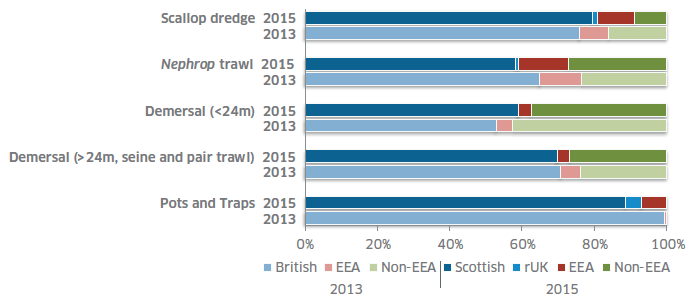Scottish Sea Fisheries Employment 2015
Second Scottish Sea Fisheries report providing information on the structure of employment and key characteristics of Scotland's sea fishing fleet.
Nationality of Crew on Scottish Vessels
A range of nationalities were represented in the 753 crews from sampled vessels. Respondents from the United Kingdom identified their nationality as Scotland, Shetland [2] and England [3] , and accounted for 67.7%, 2.5% and 1.6%, respectively ( Table 2). Crews from the European Economic Area ( EEA) totalled 8.1% of those sampled and came from six countries - Ireland, Latvia, Lithuania, Poland, Romania and Spain. Crews from non- EEA countries totalled 19.3% and came from four countries - Philippines, Ghana, Sri-Lanka and Belarus.
From the sampled crews, Romanian and Latvian crews accounted for the majority of fishers from the EEA - 48% and 35%, respectively. Filipino and Ghanaian crews account for the majority of crews from non- EEA countries - 80% and 15%, respectively. Between the 2013 and the 2015 survey, the percentage of Ghanaian crew sampled has changed from 1.3% in 2013 to 2.9% 2015. Romanian crew, who were absent in the 2013 sample, made up 3.9% of the sampled crew in 2015 ( Table 2).
Table 2: Percentage nationality of crew in the Scottish fleet (n = 753)
| UK | EEA | non- EEA | |||
| Scotland | 67.7% | Ireland | 0.1% | Philippines | 15.4% |
| Shetland | 2.5% | Latvia | 2.8% | Sri Lanka | 0.9% |
| England | 1.6% | Lithuania | 0.4% | Belarus | 0.1% |
| UK/South Africa | 0.1% | Poland | 0.8% | Ghana | 2.9% |
| |
|
Romania | 3.9% | |
|
| |
|
Spain | 0.1% | |
|
| Total | 71.9% | |
8.1% | |
19.3% |
Figure 1 shows the distribution of crew across different sea areas by nationality. In 2015, 28% of non- EEA crews were working on vessels that fished predominantly in the North Sea, a change from 24% in the 2013 survey. The larger share of EEA crews work on vessels operating in the West of Scotland. While the proportion of sampled EEA crew working in the West of Scotland has changed from 8% in the 2013 survey to 16% in the 2015 survey, an opposite pattern is observed in the North Sea from 8% in the 2013 survey to 3% in the 2015 survey. Overall the West of Scotland appears to have seen a slight decrease in sampled British (Scottish/ rUK) crews from 81% to 75%, whilst the North Sea remains stable at 68-69%. The changes highlighted should not necessarily be interpreted as trends due to sample differences between 2013 and 2015.

Figure 1: Proportion nationality by main sea area in 2013 (n = 802) and 2015 (n = 695)
The crews on sampled vessels were grouped by their role at the time of the survey. These are:
- skipper or owner/skipper: ultimately in charge of the operation of the vessel;
- engineer: charged with the running of the vessel and its equipment; and,
- deckhands: working on the deck with the fishing gear and clearing and sorting catch.
Almost all skippers and skipper/owners in the sample were Scottish or from the rUK. Only 1% of skippers and skipper/owners came from the EEA. Most of the surveyed EEA and non- EEA crews worked on Scottish vessels as engineers and deckhands. Non- EEA crews accounted for a sizeable proportion of both engineers and deckhands - 23% and 30%, respectively. EEA crews accounted for 9% and 12% of engineers and deckhands, respectively (Figure 2). There are no major differences in the distribution of crew by nationality between the 2013 and 2015 samples. The non- EEA engineers are the only exception; they represented 23% of all engineers in the 2015 sample compared to 17% in 2013 ( Figure 2).

Figure 2: Proportion of crews by nationality and position on vessel in 2013 (n = 834) and 2015 (n = 748)
Table 3 presents the distribution of crew positions by nationality. Scottish crews accounted for the highest proportion of crews in all positions. This is followed by Filipinos as engineers and deckhands at 21.9% and 23.5% respectively. Latvians accounted for 6.3% of engineers and 3.7% of deckhands of crew on sampled vessels, while Romanians account for 1.6% of engineers and 6.2% of deckhands. Ghanaians were the other notable group amongst crews on the sampled vessels - 5.1% of all deckhands ( Table 3).
Table 3: Percentage of nationality of crew in the Scottish fleet (n = 753)
| Skipper/Owner | Skipper | Engineer | Deckhand | |
| Scotland | 90.7% | 93.2% | 59.4% | 55.1% |
| Shetland | 6.0% | |
6.3% | 0.9% |
| England | 2.7% | 1.4% | 1.6% | 1.2% |
| Ireland | 0.5% | |
|
|
| Latvia | |
1.4% | 6.3% | 3.7% |
| Lithuania | |
|
|
0.7% |
| Poland | |
|
1.6% | 1.2% |
| Romania | |
1.4% | 1.6% | 6.2% |
| Spain | |
|
|
0.2% |
| Philippines | |
|
21.9% | 23.5% |
| Sri Lanka | |
|
1.6% | 1.4% |
| Belarus | |
|
|
0.2% |
| Ghana | |
|
|
5.1% |
| UK/South Africa | |
|
|
0.2% |
The sectors using mobile fishing gears - scallop dredge, Nephrops trawl, and the large and small demersal trawlers - accounted for all non- EEA crews in the sample. The demersal under 24m sector had the largest share of non- EEA crews - 38% in 2015, followed by Nephrops trawl and the demersal over 24m, seine and pair trawl - both at 27%. Anecdotal evidence suggests that the lower proportion of non- EEA crews on the larger demersal vessels is due to their stronger economic performance, which has enabled vessels in this sector to maintain original crews and not shift to non- EEA at the same rate as the smaller demersal and Nephrops vessels. The crews on pot and trap vessels in 2015 were 89% Scottish, 5% rUK and 7% from EEA countries ( Figure 3).

Figure 3: Proportion of crew by nationality and sector in 2013 (n = 810) and 2015 (n = 749)
Contact
There is a problem
Thanks for your feedback